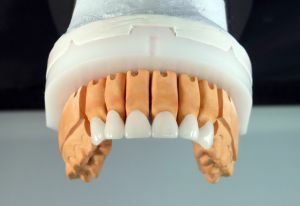 Zirconia is a substance of high enough strength. This material is used in the manufacture of dental crowns for prosthetics.
Zirconia is a substance of high enough strength. This material is used in the manufacture of dental crowns for prosthetics.
In zirconia, unlike other substances, there is very high compatibility with living human tissues. When installing dentures made from this substance, there is no need to depulpate the teeth.
In addition, the material has hypoallergenic properties. Crowns made of zirconium dioxide are visually indistinguishable from ordinary teeth when viewed from different viewing angles and with any kind of lighting.
Zirconium oxide is light, durable and sufficiently durable for use in dentistry and has a rather long service life.
If you care for your teeth correctly, crowns made from this material will remain usable for 10 years. The period of habituation to zirconium teeth is relatively small.
Contents
- Zirconium ceramics in dentistry
- Features of prosthetics using zirconium
- Prosthetic stages with zirconium crowns
- Advantages of zirconium prosthetics. ..
- . .. and shortcomings
- The process of manufacturing zirconia crowns
- The word for the patient
- Zirconium coating of crowns
- The cost of prosthetics
Zirconium ceramics in dentistry
ModernDentistry provides a large list of various prosthetic designs, with differentand mechanisms for fixation, differing in the mode of wearing, as well as the materials from which they are made.
Based on the data obtained from the clinical picture, doctors, together with patients, choose the most suitable variant of the prosthesis.
In dental practice, the technology of development of dentures that do not contain metals is continuously developing.
One of such technological innovations today is zirconium dioxide, which is not inferior in some respects even to 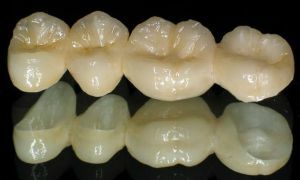 products made of metal, which can be used in dentistry. At the same time, zirconium frameworks do not have the drawbacks inherent in metal products.
products made of metal, which can be used in dentistry. At the same time, zirconium frameworks do not have the drawbacks inherent in metal products.
When creating frames from this material, the computer milling technology is applied, which allows achieving high accuracy in the manufacturing process. First of all, a zirconium frame is created, corresponding to the color of the tooth, and then a special ceramic mass is applied to it.
In dentistry this material has been used for more than fifteen years. Zirconia ceramics provide durability of the visual characteristics of the dental crown and its shape.
The material has a high light permeability, close to those with real tooth tissues.
After the evaluation of the results of the use of zirconium prostheses in dental practice, it was proved that such products are of high efficiency and can be used to create various dental crowns, inlays, bridges, implants.
Zirconia is considered to be one of the most reliable materials with an extended range of indications, which is well perceived by a large number of patients and attracts them with their ideal aesthetic visual characteristics.
Features of prosthetics using zirconium
There are two main options for creating zirconia zirconia blanks for milling:
- For milling material in fully synthesized state, a rather powerful machine is needed. The duration of the
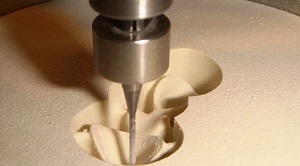 process of creating one product is approximately 2 hours. At the same time, consumables wear out very quickly.
process of creating one product is approximately 2 hours. At the same time, consumables wear out very quickly. - Processing of material in the lime-like consistency of , followed by a sintering procedure. This technology makes it possible to reduce the duration of milling of one product to 10 minutes and significantly increase the service life of consumables. Lime-like consistency of the material makes it possible to color it in accordance with the shade of dentin. The porous framework is placed in a container with a colorant before the final agglomeration. After the firing procedure, the denture carcasses take on their shape and strength.
Given the possibility of using several varieties of zirconium dioxide blanks, dentists can dissect supporting teeth in different ways depending on the specific clinical situation. For example, translucent dioxide can be used with a small distance between the upper canines and incisors.
The possibility of coloring the material prior to sintering without the need for ceramic tiling in a similar situation is very important. This feature of the workpiece makes it possible to replace the defect, as well as protect the ceramics from various overloads without damaging the visual qualities of the product. In this case the probability of destruction of hard dental tissues is reduced to a minimum.
The possibility of processing anatomical crowns increases the convenience of their use when creating counter-crowns, when you need to fix the height of the bite.
If the dentition is to be shunted with parodontal inflammation, milled tires are used.
To ensure that the future design is securely fixed, the dentist creates special retention points on the tongue surface by means of preparation, and then receives an impression, which is later scanned in the milling center for subsequent tire modeling.
Tire-prostheses can be created when the defects of the dentition are observed in the shunting area. To complete the creation of products from zirconium dioxide, it is necessary to use a ceramic facing substance with the possibility of thermal expansion corresponding to the ceramic frame.
This quality of prostheses can be achieved only if all technological requirements are met. The probability of damage to the lining material will be minimal if the design of the product is made correctly and the uniformity of the ceramic layer is fully observed.
When the facing material is fired, the probability of its deformation is minimal because the melting temperature of zirconium is very high.
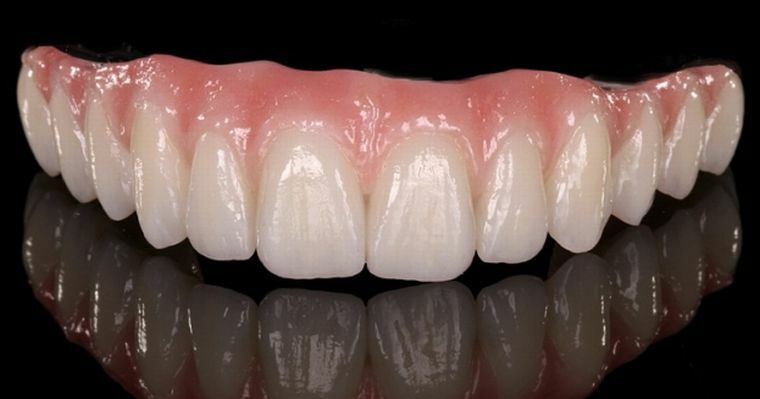
The stages of prosthetics with zirconium crowns
The procedure for prosthetics with zirconium crowns includes several basic stages:
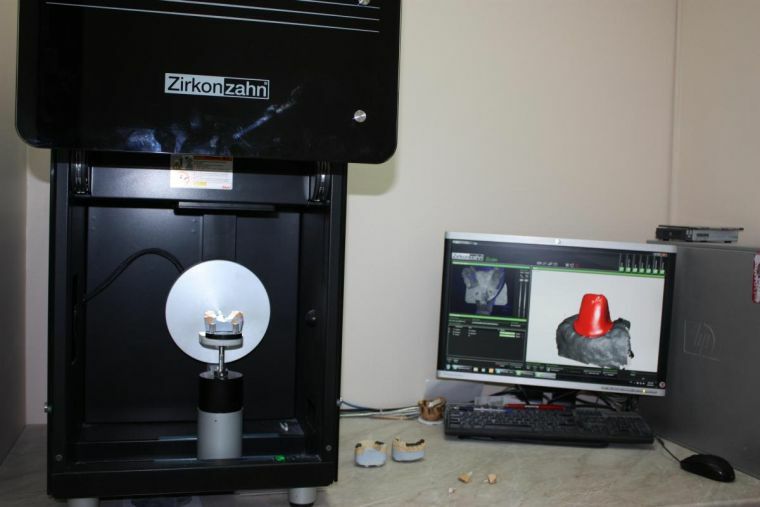
The development of zirconium crowns on the
- computer is a preparatory stage, on which special glass fiber pins are mounted, equipped with sufficiently high light transmission properties;
- professional tooth preparation always requires the use of high-quality equipment;
- is then followed by an impression of the prepared teeth;
- installation of temporary crowns on the prepared teeth;
- then follows the stage of manufacturing the workpiece of the future skeleton;
- further the workpiece is milled and painted in the desired color;
- then the technicians can transgress to the stage of artistic decoration of the product;
- after completing all the finishing work, the fitting of the constructed structure is carried out.
Advantages of zirconium prosthetics. ..
Compared with other materials, dentures created from zirconia have the following advantages:
- Crowns will remain in a usable condition, for 15 years .
- The manufactured products fit perfectly to the gums of the , thanks to the use of modern digital equipment. Soft tissues of the oral cavity remain intact, and the remains of food and such excreta as saliva do not fall under the prosthesis. Due to this, there is no favorable environment for the multiplication of various bacteria.
- The visual characteristics of zirconium teeth remain unchanged for a very long time.
- The strength of the material makes it possible to place crowns absolutely on all teeth.
- Specialists are able to reproduce the structures of zirconium dioxide, completely identical in terms of visual characteristics and transparency with the teeth of .
. .. and disadvantages of
In addition to the numerous advantages of zirconia when used in dentistry, it is necessary to highlight a significant drawback.
The cost of products from this material is so high compared to other available means that not everyone can afford to afford zirconium crowns.
The process of manufacturing zirconia crowns
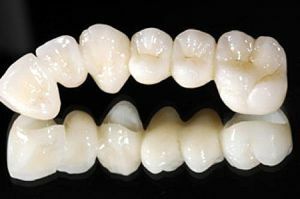 In the industrial production of blanks, one-axial pressing is sometimes performed. This technology often causes some inconveniences in the subsequent determination of the degree of shrinkage of the material during its synthesis.
In the industrial production of blanks, one-axial pressing is sometimes performed. This technology often causes some inconveniences in the subsequent determination of the degree of shrinkage of the material during its synthesis.
The main method used to produce fully homogeneous preforms is the cold isostatic compression technology.
In modern dentistry, 3 different types of workpieces from this material are used:
- High Strength Zirconia : 1,500 +/- 50 mPa. It is a non-dilute zirconia dioxide used for milling carcasses when creating prostheses for the treatment of distal defects with the absence of several teeth. Also successfully used for processing crowns fixing the height of the bite. The material can be used in the production of interlining tires, artificial prostheses, as well as carcasses for abutments, etc. Dental crowns are stained by placing the milled cages into a special composition before the sintering. This makes it possible to carry out a through painting of the frame. This eliminates the possibility of the need for further development.
- Full Contour Zirconia( Super High Translucency): 900 +/- 100 mPa .The increased translucency of the substance makes it possible to carry out milling works to create not only anatomical crowns, but also bridge prostheses. The peculiarity of staining is the application of the composition from the outside and from the inside with the use of microbrushes or specially designed brushes. With the use of such technologies, the dental crown can be painted before sintering.
- High Translucency Zirconia: 1,100 +/- 50 mPa .The translucency index of the material is about 30%.Thanks to this feature, manufacturers are given the opportunity to create crowns that have a special aesthetic appeal. Most of this material is used for prosthetics of teeth located in the frontal area. The carcass is painted using a technology identical to that of the non-transfer material.
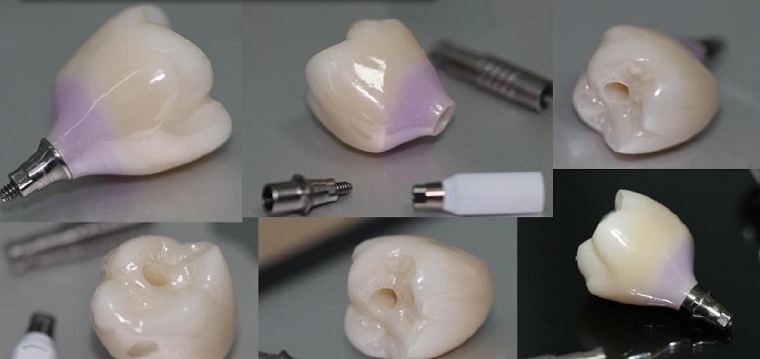
Milling of skeletons for abutments
The service life of zirconium crowns, for the creation of which one of the above technologies was used, is about 15 years.
A word to the patient
A review of a patient who had teeth made of zirconium back in the 93rd.
I received tooth crowns from zirconium dioxide back in 1993.For this, new modern equipment was used.
Dentists underwent advanced training courses in Germany. Pleasure it was not cheap, but after checking with another dentist, you can conclude that the dentures I put really high-quality.
Thanks to modern equipment and means of anesthesia, I practically did not experience pain at all stages of the installation of a new denture. For me this is important, since I am afraid of going to the dentists since my childhood. The price, of course, slightly bites, but the quality of the crowns of zirconia is excellent.
The appearance of the prosthesis practically does not differ from the real teeth. Crowns have served me for more than 10 years. I'm still satisfied with their quality.
Sergey, 49
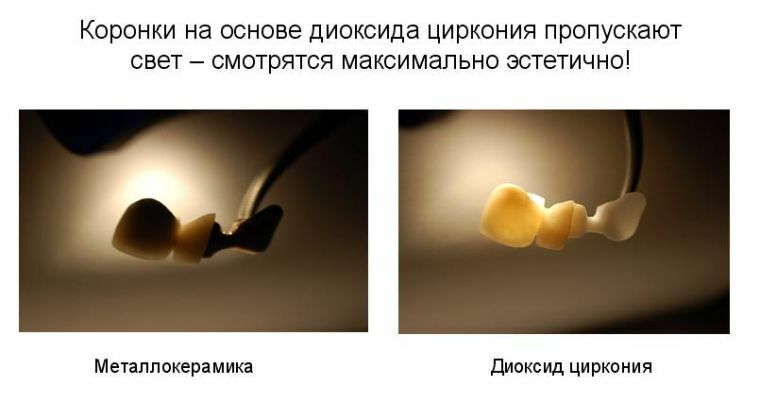
Zirconium sputtering of crowns
Sputtering technology is a zirconium layering on the surface of crowns made of metal. Thanks to this technique, reliable protection against contact of metal elements with the oral cavity is provided.
This technology prevents the occurrence of an allergic reaction, as well as other undesirable effects of possible oxidation.
Zirconium sputtering can be called a budgetary version of one-piece ceramic crowns, which, although not endowed with a full list of the advantages of zirconium, but still has the main advantages of this material.
Cost of prosthetics
Consider the average cost of prosthetics using zirconia crowns:
- fiberglass pin and its installation - 750 r;
- restoration for prosthetics - 600 r;
- installation of the temporary crown - 600 r;
- temporary installation of a special orthopedic product - 150 r;
- ceramic product made of zirconium dioxide - 6000 r;
- print with A-silicone - 600 r;
- cementing of the product for the composition of double curing - 450 r.
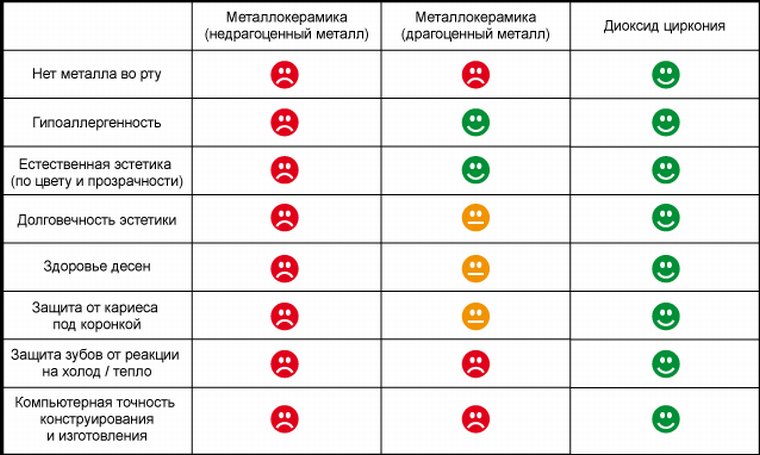
Dental prosthetics using zirconia are considered to be one of the most expensive today. In this case, the products are of quite high quality.
By the degree of transparency, the material can be compared with real teeth, and the strength of zirconia is not inferior to metal products.
